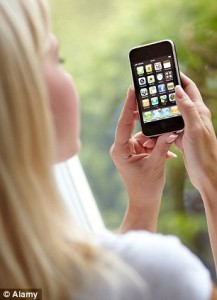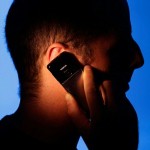この10年で脳腫瘍が50%増加している。
誰か、その理由はわかるだろうか?
小児腫瘍学会は国立統計局ONSによって公表される数字を強調している。
そして、それは1999~2009年に前頭葉および側頭葉の腫瘍が50パーセント増加して要ることをを示している。
ボルドー・スガラン大学での小児の脳腫瘍発生率は年間1~2パーセントの増加を表している。一方ONSの数字は発生率が1999年以降100,000人につき2から3まで上がったことを示す。
『我々人類で最大の実験』:世界50億人のモバイル・ユーザは、学会では潜在的脳ガン・リスクの研究が必要とされていると警告している。
- 携帯電話と脳ガンを使用することの潜在的つながりの独立研究のためのロンドン電話会議の科学者
- ONSからの図は、1999年以降脳腫瘍の50パーセントの増加を表す
- 研究する『問題を議論のために未解決のままにして、裂けた50/50′は、結ある
- しかし、『我々の種の歴史の最大の技術的実験』から信者懸念落伍者の数
耳の近くに:癌科学者は、携帯を使用する危険の完全な調査を望む
今日ロンドンで始まっている科学的な会議は、世界中の政府に携帯電話を使用することが頭の癌の成長を促すという可能性の独立研究を支持するよう迫る。
Cancer会議によるChildrenはちょうど国立Statisticsの局によって公表される数字を強調する。そして、それは1999~2009年に正面のおよび側頭葉腫瘍の50パーセントの増加を示す。
ボルドー・スガラン大学からの図が小児で脳ガンの1~2パーセントの一年の増加を表す間、ONS数字は事件率が1999年以降100,000人につき2から3まで上がったことを示す。
科学者と研究者は、携帯電話からの放射線によって癌が起きるという示唆について、長く議論した。関連があると考えている人々は ― 世界的に使用されている50億台の携帯電話で ― 緊急の研究がリスクを確立するために実施されなければならないと言う。
しかし、誰でも同意するというわけではない。政府、電話会社と衛生機関が携帯電話使用を最小にすることについて予防のアドバイスをする間、携帯を使用することが呼び出しまたはテキストによって乱れていることのため車を衝突させているとき、Health Protection Agencyは木曜日にその唯一の確立したリスクに与えられるべきものである報告で終わりそうである。
デニスHenshaw教授(ブリストル大学の人間の放射線照射効果の名誉教授)は、今日、ウエストミンスターで3日の会議を開いている。
彼は以前携帯電話パケットのシガレットスタイルの警告を主唱して、より独立研究を主張する。
Henshaw教授は以下のように述べた:『巨大な数の人々は、携帯電話を使用している、そして、彼らは健康問題の時限爆弾であることができた-ちょうど脳腫瘍でなく、受胎能も、深刻な公衆衛生問題である。
『喫煙アルコールと大気汚染の健康影響はよく知られていて、よく話される、そして、我々がこれの証拠について公然と述べていなければならないことは完全に合理的である、しかし、それは起こっていない。
『ウマがとうが立つ前に、我々はドアを閉めたい。』
もっているトラック:小児脳ガン患者の数の増加があった、そして、ONSは脳腫瘍の増加も観測した
それが携帯電話を『おそらくcarginogenicである』と分類したとき、Cancer(IARC)の上のResearchのためのインターナショナルAgencyは昨年非常ベルを鳴らした。
ダライアスLeszczynski教授(放射線とフィンランドの核的安全当局の)は、以下のように述べた:『初めて、非常に顕著な評価報告は、非常に公然と、そして、はっきり、それを述べる:RF-EMF[無線周波数電磁界]は、おそらくヒトに発癌性である。
上昇している小児における癌
ボルドー・スガラン大学のCancer Prevention単位のためのEpidemiologyから、アニーSascoスピーカー博士は、小児で脳ガンの1~2パーセントの一年の増加を強調する。
彼女には、小児の頭脳の上で放射線の影響に対する懸念がある。
彼女は以下のように述べた:『電磁波の浸透が脳に4センチメートルを選ぶ場合、成体脳への4センチメートルはまさに側頭葉である。
『あまり多くの重要な機能が側頭葉にない-しかし、小児において、より中央脳構築物は露出しそうである。
『加えて、子供はより薄い、より少ない保護薬である頭蓋骨が認められる、彼らには脳で水のより高い満足があるので、彼らがより多くの同じ放射線を吸収する多くの理由がある。』
小児で脳ガンの増加についてインディペンデントに話して、彼女は言った:『年齢でない、遺伝子的であることはあまりに急速である、そして、それは全て生活様式に出さない、そう、それは環境の何でありえるか?
「我々は現在電子スモッグで生きる、そして、人々は我々が生物学的影響を持つために研究室で示した無線デバイスにさらされる。
『それぞれに資金を助成された科学者によって、大きい数において、実験的研究があまり急速にされていないことは、全く非倫理的である。
『産業はちょうどそれらの職務をしている、私は問題がないと言っているいわゆる独立科学者と機関により心を奪われている。』
『人は、IARCモノグラフが理化薬剤の発癌性の評価の「金の標準」と思われるのを思い出さなければならない。
『IARCが非常に明らかにそれを言う場合、それの充分な科学的な理由がなければならない、または、IARCはそのような請求の後にその評判を置かない。』
しかしながら、誰でも有意なリスクが携帯電話放射線からあると考えているというわけではない。
ケン・フォスター(フィラデルフィア大学の生物工学の教授)は、IARCの分類を軽視した。
彼は、言いながら、Science Based Medicineの上で提示される:『何かが「可能な発癌物質」であると言うことは、少し腕時計が盗まれたとき彼がストアにいたので、誰かが「考えられる万引き」であると言うようである。
『本当の問題は何が携帯電話が実際に癌を引き起こすという証拠であるかということである、そして、答えはそうである-いずれも衛生機関をそんなに説得しない。』
インディペンデントは、研究が携帯電話が健康に有害なものを有するが、携帯電話業界によって資金を供給されている健康リスクを意味していない研究のおよそ4分の3でカリフォルニア大学(資金提供ソースが考慮される場合、その人はバランスが変化すると言った)でジョエル・モスコウィッツ、Familyのためのセンターの責任者とCommunity Healthから研究を指し示したかどうかについて、50:50にほとんど分割されると伝えていた。
彼は、新聞を言った:『その「我々は、より多くの研究を必要とする」ことがそうであるマントラ本当の、しかし、工業のおかげを被っていない専門医のチームによって実施されるより良好な安全情報、より厳しい規則、大量の公教育とそれぞれに資金を供給された研究を正当化するすでに十分な証拠が、ある。
矛盾する視界:
『これは我々の種の歴史で最も大きい技術的実験である、そして、我々は潜在的リスク ― 我々がまだほとんど何も知らないリスク ― のまわりに我々の頭を砂に埋めようとしている。』
- ジョエル・モスコウィッツ、カリフォルニア大学
『たとえリスクが100万のまだわずか1であるとしても、50億人の電話使用者と、それは多くの余分の脳ガンを意味する。』
- デニスHenshaw教授
『何かが「可能な発癌物質」であると言うことは、少し腕時計が盗まれたとき彼がストアにいたので、誰かが「考えられる万引き」であると言うようである。』
- ケン・フォスター教授
『これは我々の種の歴史で最も大きい技術的実験である、そして、我々は細胞、器官、生殖、免疫系、行動、我々がまだほとんど何も知らないリスクに潜在的リスクのまわりに我々の頭を砂に埋めようとしている。』
政府と移動電話会社はしばしばリスクを軽く扱う、そして、英国のモービルOperators協会は『逆健康効果の信用できる証拠でない』があると言う。
保健省は以下のように述べる:『予防措置として、小児は基本的目的のために携帯電話を使用しなければならなくて、すべての呼び出しを短く保たなければならないだけである。我々は、レビュー中ですべての科学的な証拠を保つ。』
NHSも、16歳未満の小児に携帯電話のそれらの使用を最小にするように勧める。
iPhone(モバイル・コンピューティングを大衆化したアップルの多機能電話)はあなたが常に少なくとも15mm離れてあなたの体からあなたの電話を遠ざけなければならないというアドバイスとともに来る-それは常に電話をそれらのポケットに置いておく人々にとっての驚きとして来る可能性がある。
電話による随伴が警告するガイド:『細胞ネットワークについて音声通話または無線データ伝送のためにあなたの体の近くでiPhoneを使用するとき、少なくとも15mm離れて、体からそれを遠ざけなさい、そして、金属部品を持っていない、そして、iPhoneと体の間に少なくとも15mmの分離を維持するキャリングケース、ベルト・クリップまたはホルダーを使用するだけにしなさい。』
他のガイド(例えばBlackBerryとともに来るもの)には、類似の警告がある。BlackBerryガイドは、使用者(特に妊婦とティーンエイジャー)が彼らの体から25mmでそれらの電話を保つように提案する。
リスクは、何であるか?350,000人の研究は、癌関連を見つけるのに失敗する
この10月デンマークに保持される検査は、およそ358,000人の電話記録に対して、医療記録を比較した。
彼らは、人々がどれくらいそれらの電話を所有したか、そして、これらの人々の何人が脳ガンを呈したか確認するために、データを相関させた。一部の使用者は、20年以上の間携帯電話を所有した。
全体で、群は『380万年』のためにそれらの電話を所有して、10,729例の腫瘍を患った。
平均人口と比較してとき、彼らは携帯電話のための第1の申込以来年、または、腫瘍の解剖学的位置によって『用量反応』関係の徴候を見つけなかった ― 送受話器が通常頭部に保持されるところに最も近い脳の領域で ― すなわち。
彼らは、『中枢神経系の腫瘍のリスク増加がなかった。そして、ほとんど証拠を因果関係に提供しなかった』と結論した。

iPhoneマニュアルさえ、人々がそれらの電話を近い体接触から遠ざけなければならないと述べる
ガイド、ほぼ皮肉にも、また、使用者が『呼び出しで過ごされる時間の量を減らす』ことを示唆しなさい。
Leszczynski教授はより強いIARC分類法のために勧める会議を使用する-『おそらくcarginogenicである』。
彼は、インディペンデントを言った:『2001年以降、特に小児のために、私は予防の計測の必要について、連続的に話した。我々は、長期間それを必要とするのに十分な証拠を有した。』
会議は、小児癌(例えば空気、食物と水と感染の化学毒素と遺伝学的効果)の他の原因についても述べる。
しかし、Cancer会議とともにChildrenから来ている主要なメッセージは、そうである:より独立研究が必要である。
デニスHenshaw教授は、インディペンデントを言った:『市民には、この情報を知っている権利がある。
『我々は因果リンクが脳ガンと携帯電話の間にあると言うことができなくて、言わない、しかし、我々がそれらを増加の1つのありうる説明と思うのは正しい、そして、市民にはこれが適切に調査されると予想する権利がある。
『たとえリスクが100万のまだわずか1であるとしても、50億人の電話使用者と、それは多くの余分の脳ガンを意味する。』
- 会議は、www.childhoodcancer2012.org.ukでオンラインで流れ出すことができる
50% increase in brain cancer over 10 years. Can anyone hear that?
The ONS figures show that the incident rate has risen from two to three per 100,000 people since 1999, while figures from BordeauxSegalenUniversityshow a one to two per cent annual increase in brain cancers in children.
‘The biggest experiment of our species’: With five billion mobile users in the world, conference calls for research into potential brain cancer risks
- Scientists atLondonconference call for independent research into potential links between using a mobile phone and brain cancer
- Figures from ONS show 50 per cent increase in brain tumours since 1999
- Studies ‘are split 50/50′ in conclusions, leaving the issue open for debate
- But believers fear fall-out from the ‘biggest technological experiment in the history of our species’
By EDDIE WRENN
Close to the ear: Cancer scientists want a full investigation into the risks of using a mobile
A scientific conference starting inLondontoday will urge governments across the world to support independent research into the possibility that using mobile phones encourages the growth of head cancers.
The Children with Cancer conference will highlight figures just published by the Office of National Statistics, which show a 50 per cent increase in frontal and temporal lobe tumours between 1999 and 2009.
The ONS figures show that the incident rate has risen from two to three per 100,000 people since 1999, while figures from BordeauxSegalenUniversityshow a one to two per cent annual increase in brain cancers in children.
Scientists and academics have long argued over the suggestion that radiation from mobile phones causes cancers. Those who believe there is a link say that – with five billion mobile phones being used worldwide – urgent research must be carried out to establish the risk.
But not everyone agrees. While governments, phone companies, and health agencies give precautionary advice about minimising mobile phone use, the Health Protection Agency is likely to conclude in a report due on Thursday that the only established risk when using a mobile is crashing a car due to being distracted by a call or text.
Professor Denis Henshaw, emeritus professor of human radiation effects atBristolUniversity, is opening the three-day conference inWestminstertoday.
He has previously advocated cigarette-style warnings on mobile phone packets and urges more independent research.
Professor Henshaw said: ‘Vast numbers of people are using mobile phones and they could be a time bomb of health problems – not just brain tumours, but also fertility, which would be a serious public health issue.
‘The health effects of smoking alcohol and air pollution are well known and well talked about, and it’s entirely reasonable we should be openly discussing the evidence for this, but it is not happening.
‘We want to close the door before the horse has bolted.’
Keeping track: There has been an increase in the number of child brain cancer sufferers, and the ONS has also spotted a rise in brain tumours
The International Agency for Research on Cancer (IARC) rang alarm bells last year when it classified mobile phones as ‘possibly carginogenic’.
Professor Darius Leszczynski, of the Radiation and Nuclear Safety Authority inFinland, said: ‘For the first time a very prominent evaluation report states it so openly and clearly: RF-EMF [radio frequency electromagnetic field] is possibly carcinogenic to humans.
CANCER IN CHILDREN ON THE RISE
Speaker Dr Annie Sasco, from the Epidemiology for Cancer Prevention unit atBordeauxSegalenUniversity, will highlight the one to two per cent annual increase in brain cancers in children.
She has concerns over the effect of radiation on children’s brains.
She said: ‘If the penetration of the electromagnetic waves goes for four centimetres into the brain, four centimetres into the adult brain is just the temporal lobe.
‘There are not too many important functions in the temporal lobe – but in a child the more central brain structures are going to be exposed.
‘In addition kids have a skull which is thinner, less protective, they have a higher content of water in the brain, so there are many reasons that they absorb more of the same radiation.’
Speaking to the Independent about the rise in brain cancer in children, she said: ‘It’s not age, it’s too fast to be genetic, and it isn’t all down to lifestyle, so what in the environment can it be?
”We now live in an electro-smog and people are exposed to wireless devices that we have shown in the lab to have a biological impact.
‘It is totally unethical that experimental studies are not being done very fast, in big numbers, by independently funded scientists.
‘The industry is just doing their job, I am more preoccupied with the so called independent scientists and institutions saying there is no problem.’
‘One has to remember that IARC monographs are considered as “gold standard” in evaluation of carcinogenicity of physical and chemical agents.
‘If IARC says it so clearly then there must be sufficient scientific reason for it, or IARC would not put its reputation behind such claim.’
However not everyone believes there is a significant risk from mobile phone radiation.
Ken Foster, professor of bio-engineering at theUniversityofPhiladelphia, downplayed the IARC’s classification.
He is quoted on Science Based Medicine as saying: ‘Saying that something is a “possible carcinogen” is a bit like saying that someone is a “possible shoplifter” because he was in the store when the watch was stolen.
‘The real question is what is the evidence that cell phones actually cause cancer, and the answer is – none that would persuade a health agency.’
The Independent said the research is split almost 50:50 on whether mobile phones pose a health hazard or not, but pointed out research from Joel Moskowitz, director of the Center for Family and Community Health at the University of California, who said that the balance changes if funding sources are considered, with around three quarters of studies implying no health risks being funded by the mobile phone industry.
He told the paper: ‘The mantra that “we need more research” is true, but there is already enough evidence to warrant better safety information, tighter regulation, mass public education and independently funded research carried out by teams of specialists who are not beholden to industry.
Conflicting views:
‘This is the largest technological experiment in the history of our species and we’re trying to bury our head in sand about the potential risks – risk we still know next to nothing about.’
- Joel Moskowitz,UniversityofCalifornia
‘Even if the risk is still only one in a million, with 5 billion phone users it means a lot of extra brain cancers.’
- Professor Denis Henshaw
‘Saying that something is a “possible carcinogen” is a bit like saying that someone is a “possible shoplifter” because he was in the store when the watch was stolen.’
- Professor Ken Foster
‘This is the largest technological experiment in the history of our species and we’re trying to bury our head in sand about the potential risks to cells, organs, reproduction, the immune system, behaviour, risks we still know next to nothing about.’
Governments and mobile phone companies often play down the risks and theUK’s Mobile Operators Association says there is ‘no credible evidence of adverse health effects’.
The Department of Health says: ‘As a precaution children should only use mobile phones for essential purposes and keep all calls short. We keep all scientific evidence under review.’
The NHS also advises children under 16 to minimise their use of mobile phones.
The iPhone, Apple’s smartphone which popularised mobile computing, comes with the advice that you should keep your phone at least 15mm away from your body at all times – which may come as a surprise to those who keep the phone in their pockets at all times.
The guide that comes with the phone warns: ‘When using the iPhone near your body for voice calls or wireless data transmissions over a cellular network, keep it at least 15mm away from the body, and only use carrying cases, belt clips or holders that do not have metal parts and that maintain at least 15mm separation between iPhone and the body.’
Other guides, such as the one that comes with a BlackBerry, have similar warnings. The BlackBerry guide suggests that users, particularly pregnant women and teenagers, keep their phone 25mm from their body.
WHAT IS THE RISK? STUDY OF 350,000 PEOPLE FAILS TO FIND CANCER LINK
A study held inDenmarklast October compared medical records against phone records of around 358,000 people.
They correlated the data to see how long people owned their phones, and how many of these people developed brain cancer. Some users had owned mobile phones for more than 20 years.
In total, the group had owned their phones for ’3.8 million years’, and suffered 10,729 cases of tumours.
When compared to the average population, they found no indication of ‘dose-response’ relation either by years since first subscription for a mobile phone or by anatomical location of the tumour – that is, in regions of the brain closest to where the handset is usually held to the head.
They concluded ‘there were no increased risks of tumours of the central nervous system, providing little evidence for a causal association’.
Even the iPhone manual states that people should keep their phone away from close body contact
The guide, almost ironically, also suggest that users ‘reduce the amount of time spent on calls’.
Professor Leszczynski will use the conference to urge for a stronger IARC classification – ‘probably carginogenic’.
He told the Independent: ‘Since 2001 I have continuously spoken about the need for precautionary measures, especially for children. We have had enough evidence to call for that for a long time.’
The conference will also discuss other reasons for childhood cancer, such as chemical toxins in the air, food and water, and infection and genetic effects.
But the main message coming from the Children with Cancer conference is: more independent research is needed.
Professor Denis Henshaw told the Independent: ‘The public have a right to know this information.
‘We cannot and do not say there is a causal link between brain cancer and mobile phones, but we are right to consider them as one possible explanation for the increase and the public have the right to expect that this is properly investigated.
‘Even if the risk is still only one in a million, with 5 billion phone users, it means a lot of extra brain cancers.’
- The conference can be streamed online at www.childhoodcancer2012.org.uk



